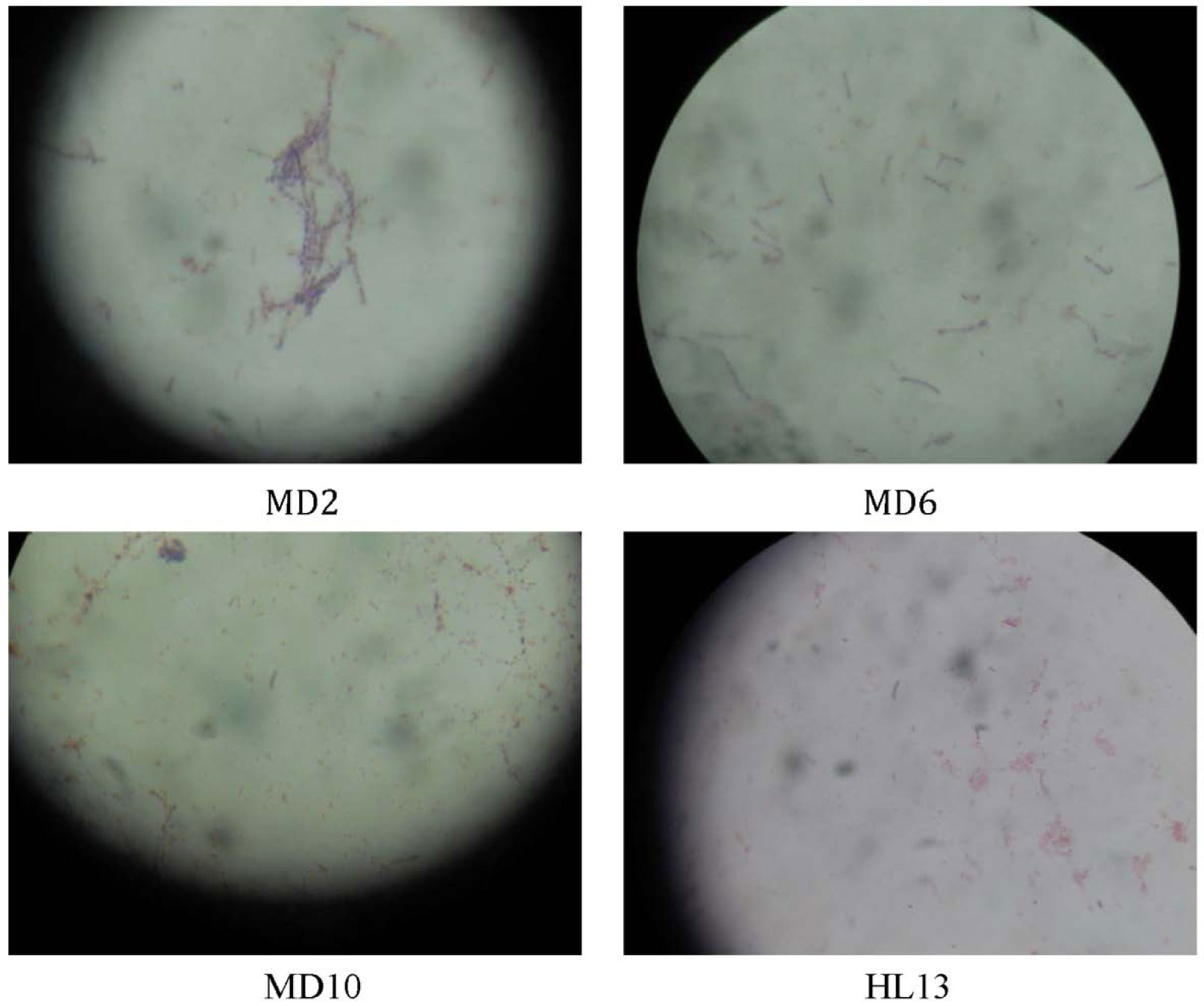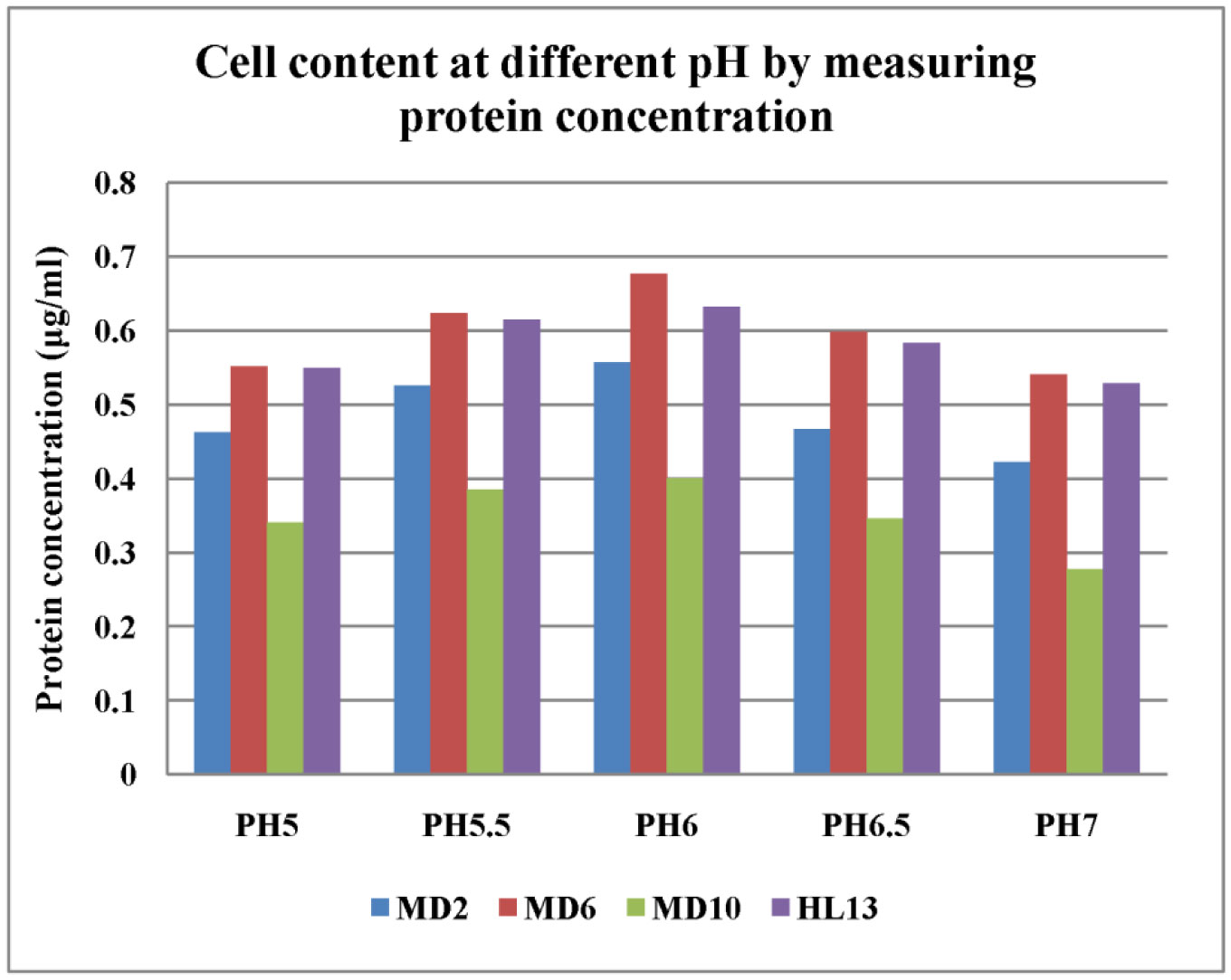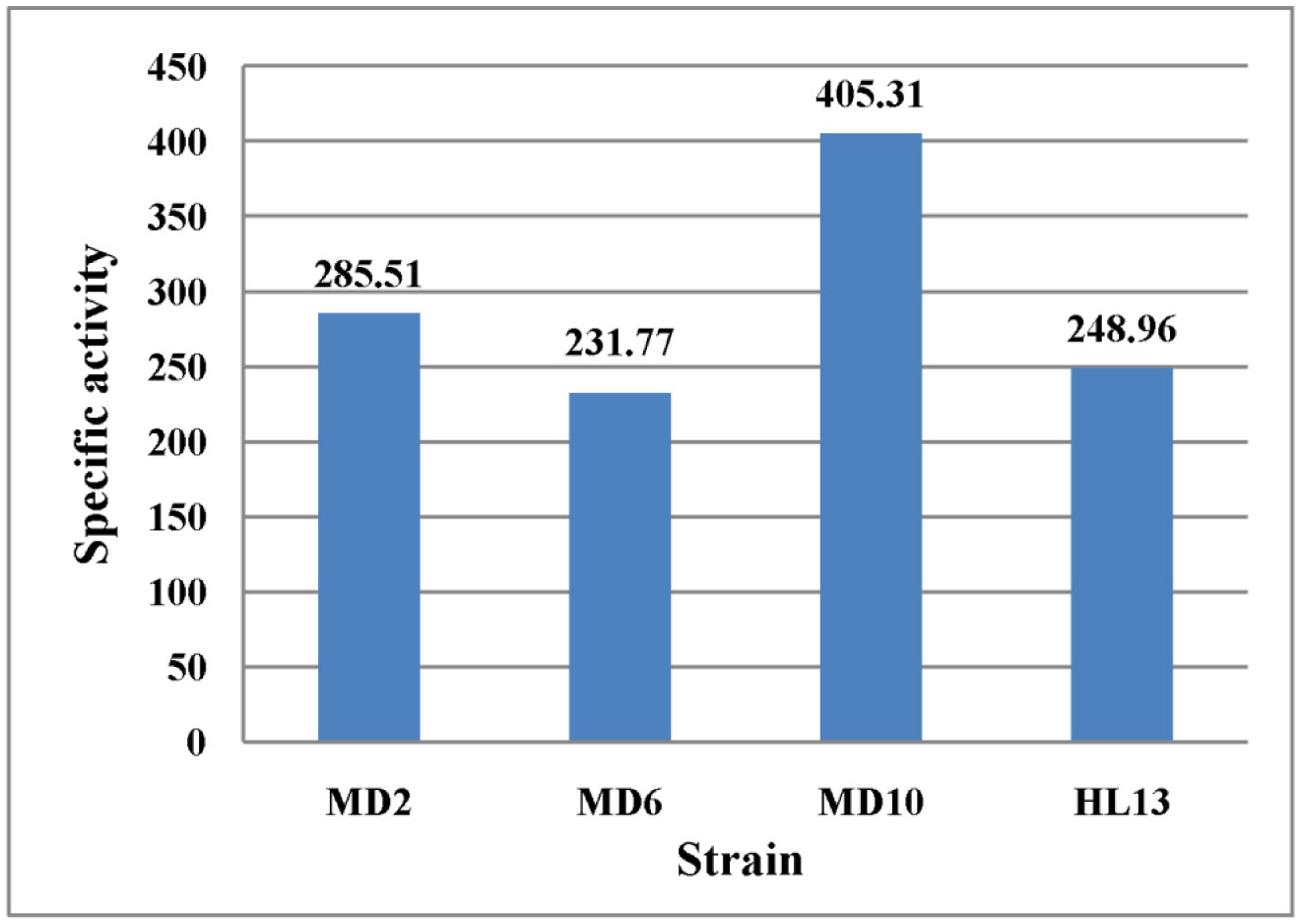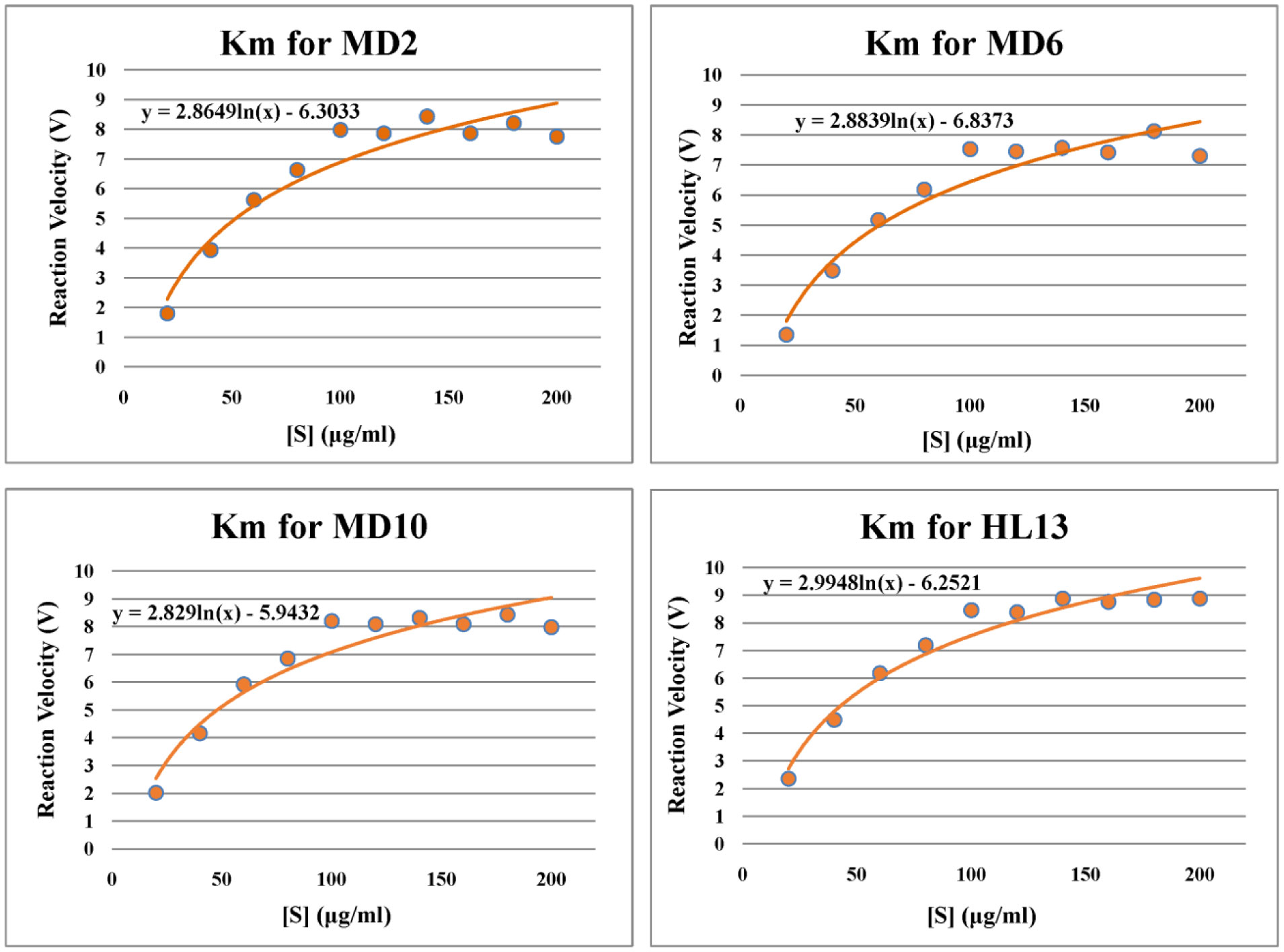1.
Introduction
The most important challenging factor in citrus fruit juice industry is the bitterness, which leads to a limiting factor for commercial acceptance of processed citrus fruit as wine, juice, vinegar etc [1]–[3]. The two flavonoid compounds namely limonin and naringin are responsible for causing bitterness to citrus fruit juice [4]. The existence of naringin was first observed in grape fruit [5]. Naringin is composed of sugar complex of α-L-rhamnose and β-D-glucose and aglycone of naringenine (4,5,7-trihydroxy-flavone) [6]. Different methods have been used to reduce naringin by chemicals like Poly (styrene-co-divinylbenzene), resin, beta-D cyclodextrin bound polymer. These methods have some drawbacks in altering nutrient composition through the removal of colour, treatment of absorptive debittering flavor and nutrients resulting in inferior fruit juice quality [7]. As an alternative strategy, microbial enzyme which is also known as environment friendly industrial biocatalyst possesses physicochemical and biological properties. These properties are being systematically developed as economically viable with the amplification of modern biotechnology [8],[9]. The enzyme naringinase also known as debittering enzyme (E.C.3.2.1.40), directly hydrolyses naringin and this mechanism reduces the bitter taste of citrus fruit juice. Naringinase, hydrolyses naringin (4,5,7-trihydroxy-flavone 7-rhamnoglucoside) and produces naringenin which is a tasteless compound (4,5,7-trihydroxy flavone) by two step of reactions (Figure 1) [10]–[12].
Naringinase has two subunits of enzyme called α-L-rhamnosidase (E.C.3.2.1.40) and β-D-glucosidase (E.C.3.2.1.23). One α-L-rhamnosidase can act on naringin and releases prunin(aglycone and β-D-glucose) and α-L-rhamnose. Second one is β-D-glucosidase which acts on prunin and releases aglycone naringenin and β-D-glucose [13]. The use of naringinase for debittering of citrus fruit juice processing provides the stability of fruit juice by improving properties [14]. Naringinase can be immobilized for industrial use to reduce the cost of debittering of juice [15]. Enzymatic hydrolysis of naringin leads to some products which play an important role as pharmacological agents such as anticancer drugs, in the treatment of atherosclerosis, with a variety of antigenic uses as vasodilator and antithrombotic purposes [16]–[19]. There are numerous applications of α-L-rhamnosidase and β-D-glucosidase as additives in food, pharmaceutical and chemical industries [3]. Naringin with its aglycone naringenin also shows different beneficial effects on health. It has been suggested that both the flavonoids play an important role in anti-inflammatory and antioxidant activities and beneficial for the treatment of obesity, diabetes, hypertension, and metabolic syndrome as well [20]. Potential use of β-glucosidase is observed in the hydrolytic removal of aglycone moiety from flavonoid and iso flavonoid glycoside.
Naringinase has been reported in plants, fungi, bacteria and yeast as well [14],[21],[22]. In the present study, four strains of naringin degrading bacteria were isolated from the soil of Psidium guajava and Terminalia chebula in Dibrugarh University Botanical Garden and investigated for naringinase activity of soil microbes and their growth conditions at different parameters.
2.
Materials and methods
All the chemicals used were of analytical grade. Naringin was procured from Sigma Aldrich.
2.1. Collection of soil sample
Soil samples were collected from the garden 40–50 cm under the soil of Psidium guajava and Terminalia chebula in Dibrugarh University Botanical Garden, Dibrugarh, Assam, India with 27′26N latitude and 94′53E longitude during the months of March to April.
2.2. Isolation of microorganism from soil sample
About 1gm of soil sample was taken and dissolved in 10 ml of distilled water present in sterilized conical flask. From the flask 0.5 ml of ten-fold serial dilution of soil sample was performed in 4.5 ml of distilled water.
2.3. Culture of microorganism
1 ml of each sample from 10-fold serial dilution was transferred and spread on plate containing nutrient Agar using a sterile pipette and a sterile glass spreader. An extra petriplate was maintained as blank. The plates were kept in an incubator at 35°C for 48 hour. Different colonies were found and counted the number of colonies. A huge number of colonies were observed in all soil samples but distinct and best colonies were found only in Psidium guajava and Terminalia chebula with no contamination. The cultures showing substantial growth were transferred to the fresh medium.
2.4. Culture of microbes in PDA
39 gm PDA (potato dextrose agar) in 1,000 ml of distilled water was mixed well and poured this slant in test tubes and petriplates. From the microbial petriplates with the help of inoculating loop streaking was done into the slanted test tubes and petriplates. It is then allowed the colonies of microbes to grow at 35°C for 48 hr in an incubator.
2.5. Screening of naringinase producing microorganism
For screening purposes 0.1 N NaOH was added to previous slanted petriplate with growing microbes to detect the presence of naringinase activity in the petriplates. After addition, zone of yellow coloured formation was observed in some colonies. From halozone producing colonies again streaking was done and cultured in PDA containing media incubated for 36 hr. In order to get single colony, streaking was repeated for about three times. Then streaked microbes were transferred into the liquid media and kept for 24 to 36 hr.
2.6. FeCl3 test
Naringinase producing microorganism was screened by using 1% FeCl3 without using assay method [23]. 0.5 ml of FeCl3 (1%) was added in the 5 test tubes containing 3 ml of liquid media and 0.5 ml of inoculum. After addition of FeCl3, the colour becomes changed from reddish brown to light brown as compared with the control. FeCl3 reacted with residual naringin resulting in light brown colour. Therefore PDA containing naringin was used to grow the naringinase producing organism.
2.7.
Pure culture for naringinase producing microorganism
The slanted test tubes that showing positive results in both NaOH and FeCl3 test were allowed to proceed for further activity. For pure culture microbes grown in the medium that contained PDA and 0.1% naringin as carbon source is maintained.
2.8.
Microbial characterization from isolated strains
Identification of bacteria was continued on the basis of colony morphology by Gram's staining reaction and catalase activity.
2.9.
Screening of pH in growth medium
30 ml of liquid media prepared in phosphate buffer were adjusted the pH levels separately to 5, 5.5, 6, 6.5 and 7. Experiments were performed in triplicates and allowed to sterilize in autoclave. Then strains were inoculated and incubated for 5 days. After five days of incubation, 1.5 ml of sample was centrifuged at 5,000 rpm for 15 minutes. Again pellet was mixed with distilled water and centrifuged at 5,000 rpm for 15 minutes. The O.D. was taken at 540 nm in U.V. spectrophotometer and detected on the basis of absorbance in which pH, the isolates show maximum growth.
2.10.
Estimation of protein concentration in growth medium
For protein estimation supernatant were separated from the pellets. The pellets were treated with 1% SDS and 0.1% Triton X-100 of 1.5 ml. Then it was centrifuged at 14000 rpm at 4°C for 5 min. O.D. was taken at 260 and 280 nm.
The concentration of protein was determined by the formula:
Cprot (µg/ml) = (1.55 × A 280 nm) − (0.76 × A 260 nm).
2.11.
Estimation of naringinase activity
The protocol for enzymatic assay was standardized by repetitively undergoing trials changing concentration of substrate only keeping the other parameters constant. The protocol followed was: 0.2 ml of supernatant was dissolved in 1ml of substrate prepared in acetate buffer at pH 4 of 0.1 M and allowed to incubate at 50°C for 30 minutes. Then 0.8 ml of NaOH (0.5 N) was added to stop the reaction followed by addition of 1ml of 1% FeCl3, waited for 10 minutes and O.D. was recorded at 422 nm. Due to less enzyme source, enzyme gets sufficient substrates for binding in 0.2 ml so that after addition of FeCl3 it showed red precipitation, indicating positive result and test tubes that showed red precipitation was continued for further experiment. The content from the test tubes was then centrifuged at 14,000 rpm at 4°C and it showed highest peak at 422 nm absorbance.
A standard graph for naringin was prepared at 422 nm to obtain the value of 1 O.D. in µg/ml. 0.5 ml of substrate and buffer followed by 0.5 ml of NaOH and 0.5 ml of FeCl3 and made different concentrations of 20, 40, 60, 80, 100 µg/ml. taking 0.5 ml of buffer as blank.
2.12.
Determination of Km
Enzymatic activity expressed in terms of amount of substrate is hydrolyzed by unit volume of the enzyme per unit time (U/ml/min). 1ml of various concentration of substrate (20, 40, 60, 80, 100, 120, 140, 160, 180, and 200) was added in 0.2 ml of supernatant incubated at 50°C for 30 minutes. 0.8 ml of 0.5 N NaOH followed by 1 ml of 1% FeCl3 was added in the test tube and waited for 10 minutes followed by taking O.D. at 422 nm.
Specific activities for all 4 microbial strains were calculated by enzyme unit per mg protein content (U/mg protein).
3.
Results and discussion
3.1. Isolation and identification
Four pure cultures obtained during the investigation were named as MD2, MD6, MD10 and HL13.Theirmorphological and biochemical characteristics were studied (Table 1). These isolates were chosen for further identification. Microbial characterizations of four isolated strains are shown in Figure 2.
3.2. Screening of pH in growth medium
The four naringinase producing microorganisms MD2, MD6, MD10 and HL13 exhibited maximum turbidity and protein content in growth in a medium of pH 6. However, pH profile of Naringinase enzyme from Aspergillus flavus showed maximum enzyme activity at pH 3.8 to 5.0 with one peak at pH 4.5 [23]–[25]. Among the four organisms, MD6 recorded the highest growth (Figure 3). Hence, optimal growth of the four isolates was observed in a media of pH 6, which therefore, was selected for further study. The turbidity of cell culture and concentration of protein (Figure 4) in the culture media have been utilized for the optimization of various growth conditions, like temperature and pH for microbial growth.
3.3. Enzymatic activity of four isolates
The naringinase activity of the four isolates was determined by following the degradation of the substrate naringin. The enzymatic activity was defined as the amount of substrate hydrolyzed by unit volume of the enzyme in unit time (U/ml/min). The naringinase activity of the four isolates was compared by calculating specific activity. Among the four isolates, MD10 showed the highest specific activity (Figure 5). The Michaelis–Menten constant (Km) of the naringinase enzyme produced by the four isolates was calculated and compared to their potential to hydrolyze the substrate naringin. Km value was observed to be the lowest and the highest respectively in MD10 and HL13 (Figure 6). Lowest value of MD10 thus indicates its higher affinity for naringin than the other three isolates. It was regarded to have a higher potential to produce naringinase in comparison to the other three isolates. On the other hand higher Km indicates that the enzymes have low affinity for the substrate and hence it needs high substrate concentration to achieve the reaction velocity. Further, lower value of Km indicates that the requirement of enzyme is only small amount of substrate to achieve the reaction velocity because it possesses high affinity for the substrate [26],[27].
The two flavonoid compounds limonin and naringin are responsible for bitterness of citrus fruit juice [4]. The concentration of naringin abundant in immature fruit but as the fruit ripens its concentration starts decreasing [26].
All the four microbial isolates showed higher enzymatic activity than the enzymatic activity reported so far [23] from Aspergillus flavus i.e. 206 U/L. Naringin an inducer in kinnow juice, mutated yeast clavispora lusitaniae and induced the production of crude enzyme naringinase with the activity of 0.0135 IU/ml and Km value of 1.0 mM and Vmax value of 28.56 mM [28]–[30]. Species of Serratia shows maximum of 9.2 U/L naringinase activity in peptone supplemented with ammonium nitrate media [4]. Aspergillus niger VB07 was isolated from the soil of citrus used to produce extracellular naringinase in a liquid medium. Naringinase yield of 17.28 IU/ml in an optimized medium containing naringin (0.1%), rhamnose (0.5%), peptone (0.25%), glycine (10 mM) at pH 4.5 and 28°C for 7 days has been obtained at shake flask level [10]. Penicillium decumbens PTCC 5,248 produces naringinase in the medium containing naringin as a carbon source. Prunin disappeared as the time of enzymatic reaction increased. Optimum pH and temperature for naringinase activity were determined to be 4.5 and 55°C respectively. The Km value of the enzyme with respect to naringin was found to be 1.7 mM [31]–[33]. Therefore all the four isolated strains show highest naringinase activity as compared to the previously reported microorganisms. MD6 although it exhibited maximum growth and highest protein content among the four isolates, it recorded minimum specific activity, thus indicating that some other proteins were also produced by the isolates which may have significance in supporting the growth of microorganism.
In order to detect whether the microbial strains were gram positive or negative, gram's test was carried out. It was observed that MD6 and HL13 was gram negative in nature. On the contrary, the other two i.e. MD2 and MD10 were gram positive bacterial strains. The microbial strains that show catalase positive test, they possess the ability to break H2O2 and thereby release water and oxygen. Among four isolates only HL13 was found to be catalase negative whereas the other three strains i.e. MD2, MD6 and MD10 were all catalase positive. All the four microbial strains were observed under microscope at the magnification of 100× and 10× eye piece and were found to be almost similar in shape. MD6 was observed to be rod shaped while MD10 was oval or rod shaped and MD2 as rod shaped and in chains and HL13 were observed slightly rod shaped.
4.
Conclusion
Thus the soil collected under the Psidium guajava L and Terminalia chebula Retz was found suitable and efficient in naringinase producing bacteria. The results obtained from this work have shown that the soil microbes could be an attractive and promising source of naringinase which will lead to the future application in citrus fruit juice industry with the main goal of debittering and maintaining organoleptic characteristics of the juice.
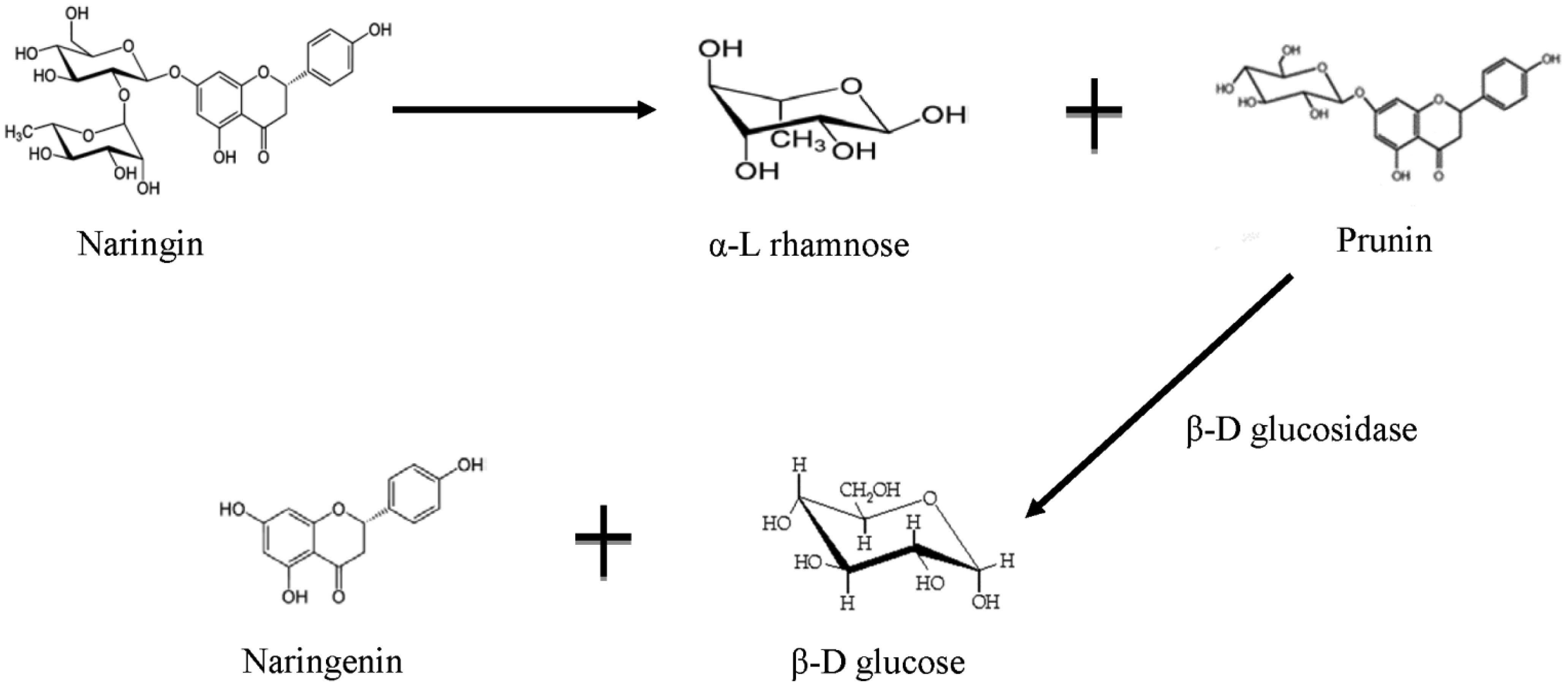









 DownLoad:
DownLoad:
